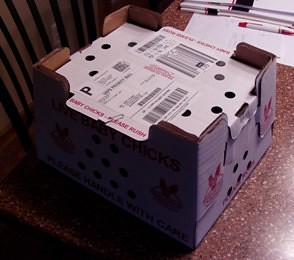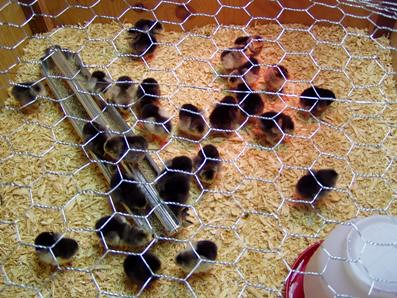 It’s time to return to the sounds of yesteryear….when…chickens ruled the roost, eggs were fresh, and housewives had their own sources of income, called ‘egg money’. It’s springtime and so it’s also time to return to the discussion of raising chickens in your own backyard. For some beginning thoughts, especially in terms of “is this ‘street legal’?”, go here:
It’s time to return to the sounds of yesteryear….when…chickens ruled the roost, eggs were fresh, and housewives had their own sources of income, called ‘egg money’. It’s springtime and so it’s also time to return to the discussion of raising chickens in your own backyard. For some beginning thoughts, especially in terms of “is this ‘street legal’?”, go here:
The Return of the Urban Chicken
If you’ve ascertained that a)it’s legal for you to have chickens in your backyard and b) it’s not going to bother the neighbors, here are some next steps.
1) What’s the goal here? Eggs? Meat? Both? If you want both, then you go for what’s called a ‘dual purpose’ bird. Meat birds tend to grow fast and get to fryer size within six weeks. Which means that you need to identify a slaughtering service right away unless you want to get into the slaughtering/plucking/dressing/processing. If you are a beginner to raising chickens, you might think of getting a dual purpose breed. Then, you can learn as you go along, identify processing resources in your area and then later when you want some dressed chickens, you can get that taken care of.
2) How important is the ‘attractiveness factor?” There are a lot of chickens that are, in my opinion, just fantastic looking..then there are the fancy breeds and then there are chickens that frankly look as if they stepped right out of “Jurassic Park III”.
3) Where do you live, as in how cold does it get where you live? If you live in a part of the country where a) it doesn’t get super cold in the winter time AND b) it gets hot and humid in the summer time, then you are looking for a whole different type of bird than if you live north of the Mason-Dixon Line. If you live in the north, you are looking for a bird with the following characteristics: ‘heavy breed’(that is, it’s got a heavy blocky body), a pea comb (that is, a teeny little bumpy comb that lays flat to the head – you do not want a ‘Foghorn Leghorn’ comb. Combs for chickens are temperature regulation devices – in the south, a big comb is an advantage and throws off a lot of body heat; in the north, a big comb will not only throw off a whole lot of body heat in the winter…it can also get frostbite. And believe me you do NOT want to have to deal with a rooster with a frostbitten comb. Not a pretty sight and not the sort of thing your average vet has been trained to deal with at State Vet College.
4) Call your local Cooperative Extension and find out if a) there is a poultry specialist on staff and if not, b) if there is a 4H Poultry Club in your area? Everything practical I ever learned about raising different livestock animals I got because we joined the 4H club for that animal; the leader of the club is usually a raiser and knows a lot. And if you do not have a vet in your area that knows about poultry, then that 4H leader is your local expert.
 To get started you are going to want to find a source for 3-day old chicks (I don’t recommend getting day old chicks until you really know what you are doing – sometimes you can get chicks hatched out by elementary school classes for scientific projects, but you will not have any control over what breed the birds are). At the end of this article are some resources – several of them give sources and links for chicks. The way getting chicks works is this: you order the chicks and specify a delivery date, which is usually a Monday. The hatchery hatches the chicks on Friday, chooses the best ones and sends them to your local post office, which then calls you on Monday morning to come pick them up. Give yourself plenty of time between the order date and the delivery date so that you can get the chicks’ new home ready for them.
To get started you are going to want to find a source for 3-day old chicks (I don’t recommend getting day old chicks until you really know what you are doing – sometimes you can get chicks hatched out by elementary school classes for scientific projects, but you will not have any control over what breed the birds are). At the end of this article are some resources – several of them give sources and links for chicks. The way getting chicks works is this: you order the chicks and specify a delivery date, which is usually a Monday. The hatchery hatches the chicks on Friday, chooses the best ones and sends them to your local post office, which then calls you on Monday morning to come pick them up. Give yourself plenty of time between the order date and the delivery date so that you can get the chicks’ new home ready for them.
Like all baby animals, chicks need to be kept warm and safe. There are all sorts of wildlife that just love baby chicks, so we don’t advocate putting them out in a henhouse or pen in the yard until they are all feathered out and have roosting available so that they can get off the ground if they need to.
What we do is this: We set up a wooden box in the basement – on a table – with a heat lamp on top, wood shavings (or shredded paper – I get this for free from my offices), and a chick waterer and a feeder. Warmth, food, water and not being attacked by anything is all you need to provide.
When the chicks arrive and you pick them up, DO NOT OPEN THE BOX until you get them home. All you need is to have the little guys jumping all over the car seats and believe me, even at three days, they are very energetic. Keep the box closed until you get them home and into their new home (put some wire mesh on top), the heat lamp on, the waterer filled and some food in the feeder. They will continue to clump up a little bit for a while to keep themselves warm(the box also is actually small enough that there is no moving room in it so that is how they’ve been practically since they were born), but they will also start to explore. If you see them constantly clumping up, then they are cold and you will need to lower the heat lamp or provide another form of heat. If you see them all the way over to the other side of the box…it’s too hot and you need to raise the lamp.
Within a few days, you will see them start to feather out and grow. You will want to raise the heat lamp as they do so that as they grow they can still get under it and get warm but not too hot. As they grow, you will need to get to work on whatever you are going to do in terms of protection for raising them: a chicken house (with a little ramp and fenced in yard) or a moveable yard with shelter in it, which some people call a ‘chicken tractor’. In this pasture-based system, you move the little fenced in box and shelter around the yard, the chickens eat the bugs and seeds and grass and you move it every day to a new place. This is a very ‘hot’ new system for raising poultry and although we raised chickens for quite some time in the past, we used a henhouse based system; this will be our first time using a pasture-based system and we are pretty excited about it.
Here are some sites that I went through that looked pretty interesting, educational and complete. To find your own resources, you can try searching on the following terms: backyard poultry raising; chicken breeds; poultry books; poultry raising systems; poultry nutrition; pasture-raising poultry; chicken tractor designs and plans; chicken house designs and plans.
http://www.chickenkeeping.com/gettingstarted.htm
http://www.grit.com/Chickens/Backyard-Chickens-Getting-Started.aspx
http://poultry.purinamills.com/LibraryArticles/GettingStartedWithPoultry/default.aspx
http://www.ithaca.edu/staff/jhenderson/chooks/chooks.html
http://www.ithaca.edu/staff/jhenderson/chooks/chlinks.html
http://poultryextension.psu.edu/
http://www.rps.psu.edu/0305/poultry.html
http://en.wikipedia.org/wiki/Chicken_tractor
http://www.cias.wisc.edu/crops-and-livestock/raising-poultry-on-pasture/
http://www.cias.wisc.edu/category/crops-and-livestock/poultry/
http://www.backyardchickens.com/
http://www.strombergschickens.com/books/chicken_books.php
http://www.vabf.org/booksmallscale.php
http://www.rodaleinstitute.org/new_farm
http://www.rodaleinstitute.org/course/M4/1
(Top chicken photo courtesy of hdod)
This post can also be found at Urban Chicken 2
